Autofocus
To use autofocus, rotate the focus-mode selector to AF.
Focus-mode selector

The camera focuses using 153 focus points, of which the 55 shown by r in the illustration can be selected by the user (0 Focus Point Selection).
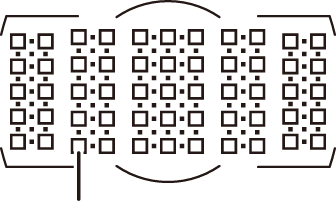
User-selectable focus points
Cross Sensors
The availability of cross-sensor focus points varies with the lens used.
| Lens | Cross sensors (cross-sensor focus points highlighted in gray 2) |
|---|---|
| AF-S and AF-P lenses other than those listed below with maximum apertures of f/4 or faster 1 |
99 cross sensors |
|
63 cross sensors |
|
45 cross sensors |
At maximum zoom, in the case of zoom lenses.
Other focus points use line sensors, which detect horizontal lines.
AF-S/AF-I Teleconverters and Available Focus Points
When an AF-S or AF-I teleconverter is attached, the focus points shown in the illustrations can be used for autofocus and electronic rangefinding (note that at maximum combined apertures slower than f/5.6, the camera may not be able to focus on dark or low-contrast subjects).
| Teleconverter | Max. lens aperture 1 | Available focus points (cross-sensor focus points highlighted in gray 2) |
|---|---|---|
|
TC-14E, TC-14E II, TC-14E III TC-17E II TC-20E, TC-20E II, TC-20E III |
f/2 |
153 focus points (55 selectable) with 99 cross sensors |
| TC-14E, TC-14E II, TC-14E III | f/2.8 | |
|
TC-17E II TC-20E, TC-20E II, TC-20E III |
f/2.8 |
153 focus points (55 selectable) with 45 cross sensors |
| TC-14E, TC-14E II, TC-14E III | f/4 | |
| TC-17E II | f/4 |
37 focus points (17 selectable) with 25 cross sensors |
| TC-800-1.25E ED | f/5.6 | |
| TC-20E, TC-20E II, TC-20E III | f/4 |
15 focus points (9 selectable) with 5 cross sensors |
| TC-14E, TC-14E II, TC-14E III | f/5.6 |
At maximum zoom, in the case of zoom lenses.
Other focus points use line sensors, which detect horizontal lines, but note that if there are only 5 cross sensors, only those shown by ■ detect vertical lines.

Autofocus is not available when teleconverters are used with AF-S VR Micro-Nikkor 105mm f/2.8G IF-ED lenses.
Autofocus Mode
Choose from the following autofocus modes:
Autofocus mode can be selected by pressing the AF-mode button and rotating the main command dial until the desired setting is displayed in the viewfinder and control panel.
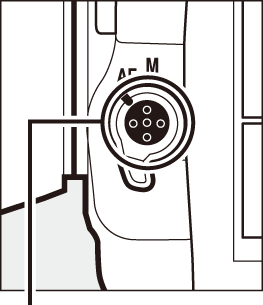
AF-mode button
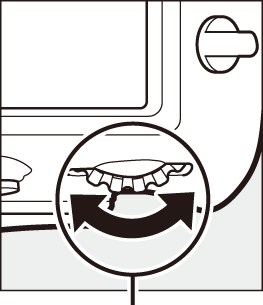
Main command dial
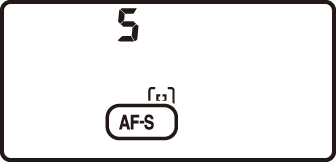
Control panel

Viewfinder
The AF-ON Button
For the purpose of focusing the camera, pressing the AF-ON button has the same effect as pressing the shutter-release button halfway.
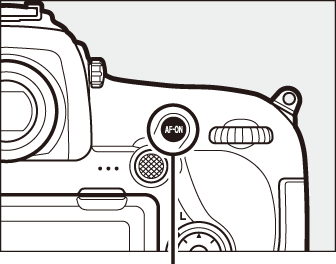
AF-ON button
Predictive Focus Tracking
In AF-C mode, the camera will initiate predictive focus tracking if the subject moves toward or away from the camera while the shutter-release button is pressed halfway or the AF-ON button is pressed. This allows the camera to track focus while attempting to predict where the subject will be when the shutter is released.
See Also
For information on:
- Using focus priority in continuous-servo AF, see A > Custom Setting a1 (AF-C priority selection, 0 AF-C Priority Selection).
- Using release priority in single-servo AF, see A > Custom Setting a2 (AF-S priority selection, 0 AF-S Priority Selection).
- Preventing the camera from focusing when the shutter-release button is pressed halfway, see A > Custom Setting a8 (AF activation, 0 AF Activation).
- Limiting focus-mode selection to AF-S or AF-C, see A > Custom Setting a10 (Autofocus mode restrictions, 0 Autofocus Mode Restrictions).
- Using the sub-command dial to choose the focus mode, see A > Custom Setting f4 (Customize command dials) > Change main/sub (0 Customize Command Dials).
- The autofocus options available in live view or during movie recording, see “Autofocus” (0 Autofocus).
AF-Area Mode
Choose how the focus point for autofocus is selected.
- Single-point AF: Select the focus point; the camera will focus on the subject in the selected focus point only. Use with stationary subjects.
-
Dynamic-area AF: Select the focus point. In AF-C focus mode, the camera will focus based on information from surrounding focus points if the subject briefly leaves the selected point. The number of focus points varies with the mode selected:
- 9- or 25-point dynamic-area AF: Choose when there is time to compose the photograph or when photographing subjects that are moving predictably (e.g., runners or race cars on a track).
- 72-point dynamic-area AF: Choose when photographing subjects that are moving unpredictably (e.g., players at a football game).
- 153-point dynamic-area AF: Choose when photographing subjects that are moving quickly and cannot be easily framed in the viewfinder (e.g., birds).
-
3D-tracking: Select the focus point. In AF-C focus mode, the camera will track subjects that leave the selected focus point and select new focus points as required. Use to quickly compose pictures with subjects that are moving erratically from side to side (e.g., tennis players). If the subject leaves viewfinder, remove your finger from the shutter-release button and recompose the photograph with the subject in the selected focus point.
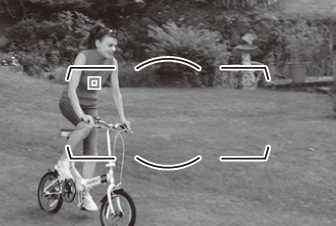
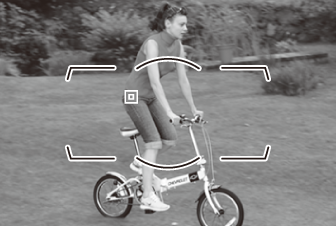
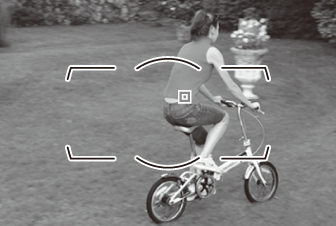
-
Group-area AF: The camera focuses using a group of focus points selected by the user, reducing the risk of the camera focusing on the background instead of on the main subject. Choose for subjects that are difficult to photograph using a single focus point. If faces are detected in AF-S focus mode, the camera will give priority to portrait subjects.
Auto-area AF: The camera automatically detects the subject and selects the focus point; if a face is detected, the camera will give priority to the portrait subject. The active focus points are highlighted briefly after the camera focuses; in AF-C mode, the main focus point is displayed after the other focus points have turned off.
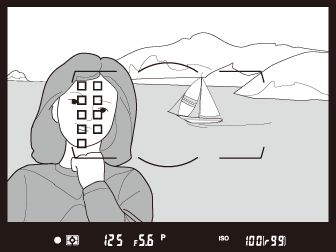
AF-area mode can be selected by pressing the AF-mode button and rotating the sub-command dial until the desired setting is displayed in the viewfinder and control panel.

AF-mode button
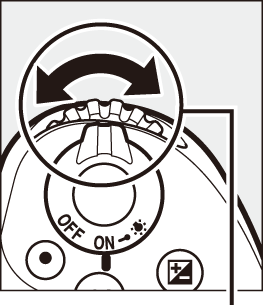
Sub-command dial
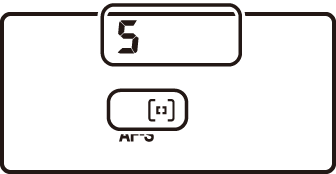
Control panel
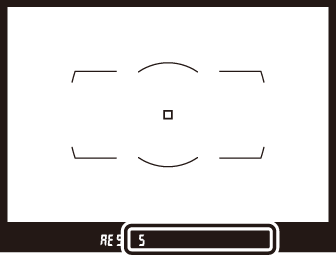
Viewfinder
3D-tracking
When the shutter-release button is pressed halfway, the colors in the area surrounding the focus point are stored in the camera. Consequently 3D-tracking may not produce the desired results with subjects that are similar in color to the background or that occupy a very small area of the frame.
AF-Area Mode
AF-area mode is shown in the control panel and viewfinder.
| AF-area mode | Control panel | Viewfinder | Viewfinder focus-point display |
|---|---|---|---|
| Single-point AF |  |
 |
 |
| 9-point dynamic-area AF * |  |
 |
 |
| 25-point dynamic-area AF * |  |
 |
 |
| 72-point dynamic-area AF * |  |
 |
 |
| 153-point dynamic-area AF * |  |
 |
 |
| 3D-tracking |  |
 |
 |
| Group-area AF |  |
 |
 |
| Auto-area AF |  |
 |
 |
Only active focus point is displayed in the viewfinder. Remaining focus points provide information to assist focus operation.
AF-S/AF-I Teleconverters
If 3D-tracking or auto-area AF is selected for AF-area mode when an AF-S/AF-I teleconverter is used, single-point AF will automatically be selected at combined apertures slower than f/5.6.
See Also
For information on:
- How autofocus adjusts to changes in the distance to the subject, see A > Custom Setting a3 (Focus tracking with lock-on, 0 Focus Tracking with Lock-On).
- Choosing whether the camera detects and focuses on faces when 3D-tracking is selected for AF-area mode, see A > Custom Settings a4 (3D-tracking face-detection, 0 3D-Tracking Face-Detection).
- Choosing the area monitored by pressing the shutter-release button halfway when 3D-tracking is selected for AF-area mode, see A > Custom Settings a5 (3D-tracking watch area, 0 3D-Tracking Watch Area).
- Choosing different focus points and/or AF-area modes for portrait- and landscape-orientation photographs, see A > Custom Settings a7 (Store by orientation, 0 Store by Orientation).
- Limiting AF-area mode selection, see A > Custom Settings a9 (Limit AF-area mode selection, 0 Limit AF-Area Mode Selection).
- Choosing how the focus point is displayed, see A > Custom Settings a12 (Focus point options, 0 Focus Point Options).
- Using the main command dial to choose the AF-area mode, see A > Custom Settings f4 (Customize command dials) > Change main/sub (0 Customize Command Dials).
- The autofocus options available in live view or during movie recording, see “Choosing an AF-Area Mode” (0 Choosing an AF-Area Mode).
Focus Point Selection
The camera focuses using 153 focus points, of which 55 shown in the illustration can be selected manually, allowing photographs to be composed with the main subject positioned almost anywhere in the frame. Follow the steps below to choose the focus point (in group-area AF, you can follow these steps to choose a group of focus points).

-
Rotate the focus selector lock to I.
This allows the multi selector to be used to select the focus point.
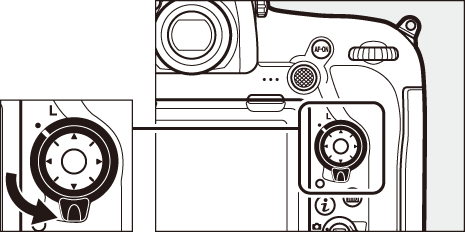
Focus selector lock
-
Select the focus point.
Use the multi selector to select the focus point in the viewfinder while the exposure meters are on.

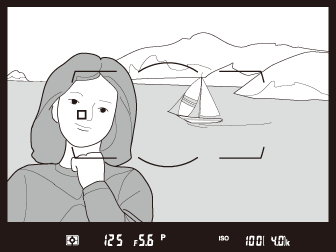
The center focus point can be selected by pressing the center of the multi selector.
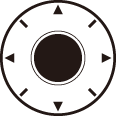
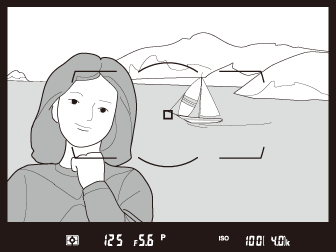
The focus selector lock can be rotated to the locked (L) position following selection to prevent the selected focus point from changing when the multi selector is pressed.
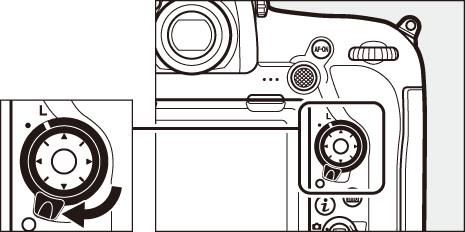
The Sub-selector
The sub-selector can be used in place of the multi selector to select the focus point. Focus and exposure lock while the center of the sub-selector is pressed (0 Focus Lock, Autoexposure (AE) Lock). Use the sub-selector as shown; pressing the sides may not have the desired effect. Be careful not to put your fingers or fingernails in your eye when using the sub-selector.
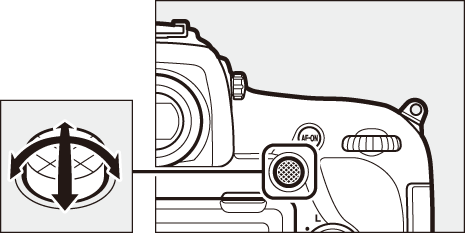
Sub-selector
Auto-area AF
The focus point for auto-area AF is selected automatically; manual focus-point selection is not available.
See Also
For information on:
- Choosing the number of focus points that can be selected using the multi selector, see A > Custom Setting a6 (Number of focus points, 0 Number of Focus Points).
- Choosing separate focus points and/or AF-area modes for vertical and horizontal orientations, see A > Custom Setting a7 (Store by orientation, 0 Store by Orientation).
- Setting focus-point selection to “wrap around,” see A > Custom Setting a11 (Focus point wrap-around, 0 Focus Point Wrap-Around).
- Choosing when the focus point is illuminated, see A > Custom Setting a12 (Focus point options, 0 Focus Point Options).
- Changing the role played by the sub-selector, see A > Custom Setting f1 (Custom control assignment) > Sub-selector (0 Custom Control Assignment) and Sub-selector center (0 Custom Control Assignment).
- Changing the role of the multi selector center button, see A > Custom Setting f2 (Multi selector center button, 0 Multi Selector Center Button).
Focus Lock
Focus lock can be used to change the composition after focusing, making it possible to focus on a subject that will not be in a focus point in the final composition. If the camera is unable to focus using autofocus (0 Getting Good Results with Autofocus), focus lock can also be used to recompose the photograph after focusing on another object at the same distance as your original subject. Focus lock is most effective when an option other than auto-area AF is selected for AF-area mode (0 AF-Area Mode).
-
Focus.
Position the subject in the selected focus point and press the shutter-release button halfway to initiate focus. Check that the in-focus indicator (I) appears in the viewfinder.
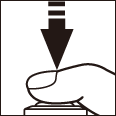
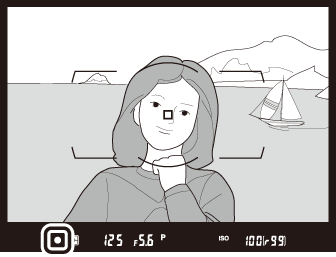
-
Lock focus.
AF-C focus mode (0 Autofocus Mode): With the shutter-release button pressed halfway (
 ), press the center of the sub-selector (
), press the center of the sub-selector ( ) to lock both focus and exposure (an AE-L icon will be displayed in the viewfinder). Focus will remain locked while the center of the sub-selector is pressed, even if you later remove your finger from the shutter-release button.
) to lock both focus and exposure (an AE-L icon will be displayed in the viewfinder). Focus will remain locked while the center of the sub-selector is pressed, even if you later remove your finger from the shutter-release button.Shutter-release button
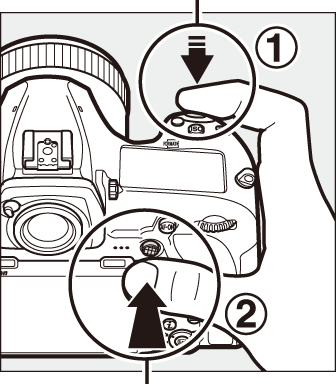
Sub-selector

AF-S focus mode: Focus locks automatically when the in-focus indicator (I) appears, and remains locked until you remove your finger from the shutter-release button. Focus can also be locked by pressing the center of the sub-selector (see above).
-
Recompose the photograph and shoot.
Focus will remain locked between shots if you keep the shutter-release button pressed halfway (AF-S) or keep the center of the sub-selector pressed, allowing several photographs in succession to be taken at the same focus setting.
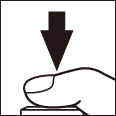
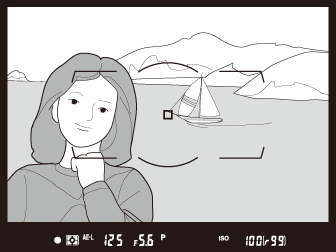
Do not change the distance between the camera and the subject while focus lock is in effect. If the subject moves, focus again at the new distance.
Locking Focus with the AF-ON Button
During viewfinder photography, focus can be locked using the AF-ON button in place of the shutter-release button (0 The AF-ON Button). If AF-ON only is selected for Custom Setting a8 (AF activation, 0 AF Activation), the camera will not focus when the shutter-release button is pressed halfway; instead, the camera will focus when the AF-ON button is pressed, at which point focus will lock and remain locked until the AF-ON button is pressed again.
See Also
For information on using the shutter-release button to lock exposure, see A > Custom Setting c1 (Shutter-release button AE-L, 0 Shutter-Release Button AE-L).
Getting Good Results with Autofocus
Autofocus does not perform well under the conditions listed below. The shutter release may be disabled if the camera is unable to focus under these conditions, or the in-focus indicator (I) may be displayed and the camera may sound a beep, allowing the shutter to be released even when the subject is not in focus. In these cases, use manual focus (0 Manual Focus) or use focus lock (0 Focus Lock) to focus on another subject at the same distance and then recompose the photograph.
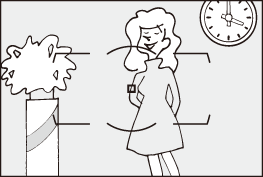
There is little or no contrast between the subject and the background.
Example: Subject is the same color as the background.
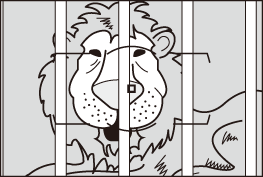
The focus point contains objects at different distances from the camera.
Example: Subject is inside a cage.
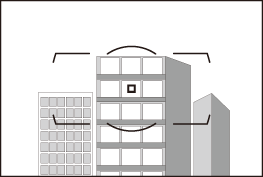
The subject is dominated by regular geometric patterns.
Example: Blinds or a row of windows in a skyscraper.
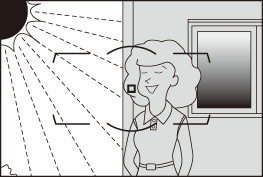
The focus point contains areas of sharply contrasting brightness.
Example: Subject is half in the shade.

Background objects appear larger than the subject.
Example: A building is in the frame behind the subject.
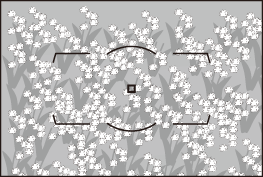
The subject contains many fine details.
Example: A field of flowers or other subjects that are small or lack variation in brightness.





